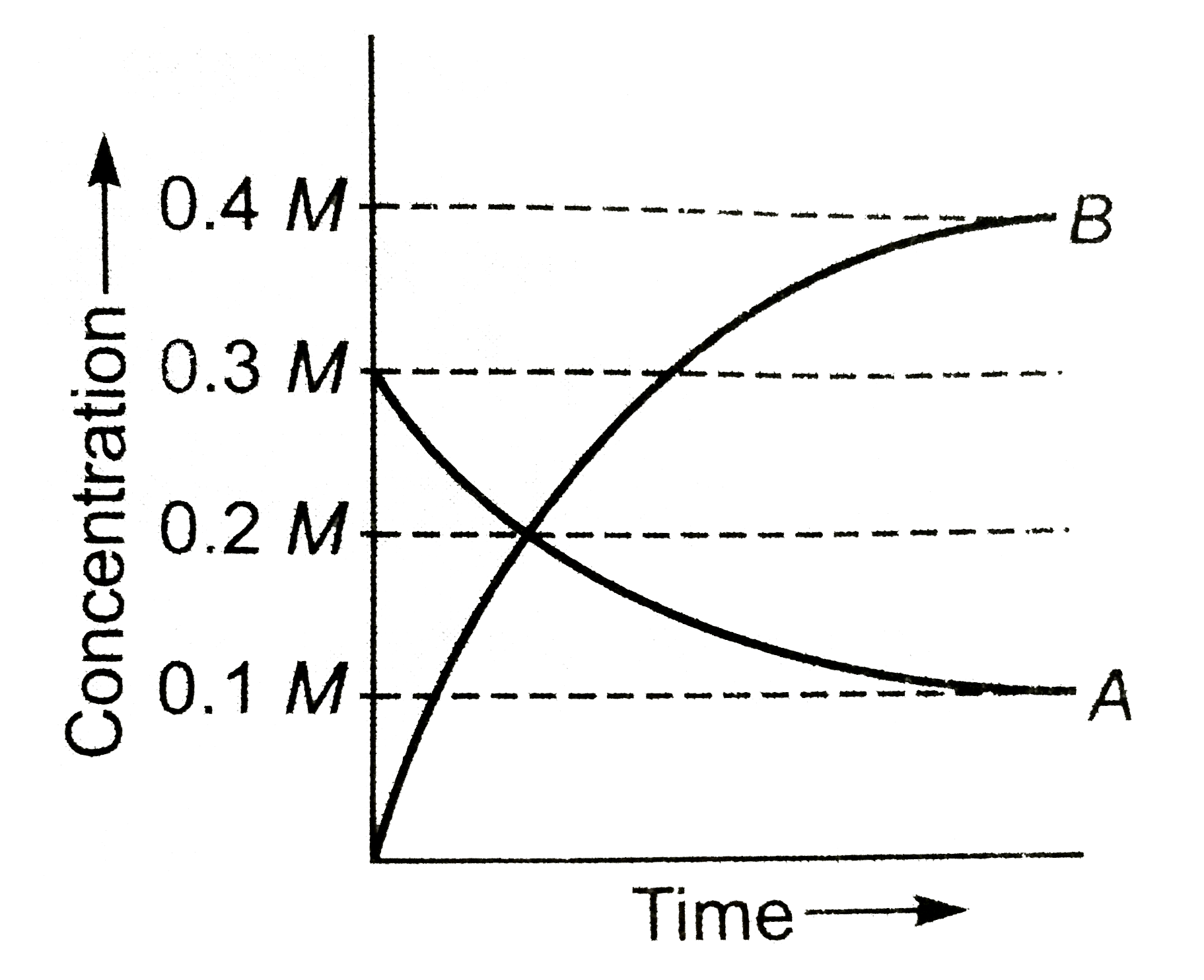Calculate the equilibrium concentration ratio of C to A if equimolar ratio of A and B were allowed to come to equilibrium at 300K.
A(g)+B(g)⇔C(g)+D(g),ΔG∘=-830 cal.
The correct Answer is:2
To solve the problem step by step, we will follow these instructions:
Step 1: Write the Reaction
We start with the given equilibrium reaction:
A(g)+B(g)⟺C(g)+D(g)
Step 2: Set Initial Concentrations
Since we have an equimolar ratio of A and B, let’s assume the initial concentration of A and B is C moles each:
- (A)initial=C
- (B)initial=C
- (C)initial=0
- (D)initial=0
Step 3: Define Change in Concentration
Let α be the fraction of A and B that reacts at equilibrium. Thus, at equilibrium:
- (A)=C(1−α)
- (B)=C(1−α)
- (C)=Cα
- (D)=Cα
Step 4: Write the Expression for the Equilibrium Constant K
The equilibrium constant Kc for the reaction is given by:
Kc=(C)(D)(A)(B)
Substituting the equilibrium concentrations:
Kc=(Cα)(Cα)(C(1−α))(C(1−α))
This simplifies to:
Kc=C2α2C2(1−α)2=α2(1−α)2
Step 5: Use the Given ΔG0 to Find Kc
We know that:
ΔG0=−RTlnKc
Given ΔG0=−830 cal, R≈2 cal/(K·mol), and T=300 K, we can substitute:
−830=−2×300lnKc
Solving for Kc:
830=600lnKc
lnKc=830600≈1.3833
Taking the exponential:
Kc=e1.3833≈4
Step 6: Set Up the Equation for Kc
Now we have:
α2(1−α)2=4
Taking the square root of both sides:
α1−α=2
Step 7: Solve for α
Cross-multiplying gives:
α=2(1−α)
α=2−2α
3α=2
α=23
Step 8: Calculate the Ratio of Concentration of C to A
The ratio of the concentration of C to A at equilibrium is:
(C)(A)=CαC(1−α)=α1−α
Substituting the value of α:
(C)(A)=231−23=2313=2
Final Answer
Thus, the equilibrium concentration ratio of C to A is:
(C)(A)=2
---
We start with the given equilibrium reaction:
A(g)+B(g)⟺C(g)+D(g)
Since we have an equimolar ratio of A and B, let’s assume the initial concentration of A and B is C moles each:
- (A)initial=C
- (B)initial=C
- (C)initial=0
- (D)initial=0
Let α be the fraction of A and B that reacts at equilibrium. Thus, at equilibrium:
- (A)=C(1−α)
- (B)=C(1−α)
- (C)=Cα
- (D)=Cα
The equilibrium constant Kc for the reaction is given by:
Kc=(C)(D)(A)(B)
Substituting the equilibrium concentrations:
Kc=(Cα)(Cα)(C(1−α))(C(1−α))
This simplifies to:
Kc=C2α2C2(1−α)2=α2(1−α)2
We know that:
ΔG0=−RTlnKc
Given ΔG0=−830 cal, R≈2 cal/(K·mol), and T=300 K, we can substitute:
−830=−2×300lnKc
Solving for Kc:
830=600lnKc
lnKc=830600≈1.3833
Taking the exponential:
Kc=e1.3833≈4
Now we have:
α2(1−α)2=4
Taking the square root of both sides:
α1−α=2
Cross-multiplying gives:
α=2(1−α)
α=2−2α
3α=2
α=23
The ratio of the concentration of C to A at equilibrium is:
(C)(A)=CαC(1−α)=α1−α
Substituting the value of α:
(C)(A)=231−23=2313=2
Thus, the equilibrium concentration ratio of C to A is:
(C)(A)=2
Topper's Solved these Questions
- CHEMICAL EQUILIBRIUMBOOK - NARENDRA AWASTHI ENGLISHCHAPTER - CHEMICAL EQUILIBRIUMEXERCISE - Level 3
1 Videos
- CHEMICAL EQUILIBRIUMBOOK - NARENDRA AWASTHI ENGLISHCHAPTER - CHEMICAL EQUILIBRIUMEXERCISE - One more Answer is/are Correct
1 Videos
- CHEMICAL EQUILIBRIUMBOOK - NARENDRA AWASTHI ENGLISHCHAPTER - CHEMICAL EQUILIBRIUMEXERCISE - Assertion- Reason Type Question
15 Videos
- ATOMIC STUCTUREBOOK - NARENDRA AWASTHI ENGLISHCHAPTER - ATOMIC STUCTUREEXERCISE - Subjective problems
1 Videos
- DILUTE SOLUTIONBOOK - NARENDRA AWASTHI ENGLISHCHAPTER - DILUTE SOLUTIONEXERCISE - leval-03
23 Videos
Similar Questions
Kp=0.04atm at 899K for the equilibrium shown below. What is the equilibrium concentration of C2H6 when it is placed in a flask at 4.0atm pressure and allowed to come to equilibrium?
C2H6(g)⇔C2H4(g)+H2(g)
View SolutionIn a gaseous reaction A+2B⇔2C+D the initial concentration of B was 1.5 times that of A. At equilibrium the concentration of A and D were equal. Calculate the equilibrium constant KC.
View SolutionA(G)+B(g)⇔C(g)+D(g)
Above equilibrium is established by taking A& B in a closed container. Initial concentration of A is twice of the initial concentration of B. At equilibrium concentraons of B and C are equal. Then find the equilibrium constant for the reaction, C(g)+D(g)⇔A(g)+B(g).
View SolutionWhat is the equilibrium concentration of each of the substance in the equilibrium when the initial concentration of ICl was 0.78M?
2ICl(g)⇔I2(g)+Cl2(g),Kc=0.14
View SolutionIn the equilibrium,AB(s)→A(g)+B(g), if the equilibrium concentration of A is doubled, the equilibrium concentration of B would become
View SolutionThe figure shows the change in concentration of species A and B as a function of time.
The equilibrium constant Kcfor the reactionA(g)⇔2B(g) is :

View SolutionThe equilibrium A(g)+4B(g)⇔AB4(g) is attained by mixing equal moles of A and B in a one litre vessel Then at equilibrium
View SolutionCalculate the equilibrium constant (Kc) for the reaction given below , if at equilibrium, mixture contains 5.0 mole of A2,3 mole of B2 and 2 mole of AB2 at 8.21 atm and 300K
A2(g)+2B2(g)⇔2AB2(g)+Heat
View SolutionCalculate partial pressure of B at equilibrium in the following equilibrium
A(s)⇔B(g)+2C(g), KP=32atm3.
View Solution3 moles of A and 4 moles of B are mixed together and allowed to come into equilibrium according to the following reaction.
3A(g)+4B(g)→2C(g)+3D(g)
When equilibrium is reached, there is 1 mole of C. The equilibrium constant of the reaction is
View Solution
